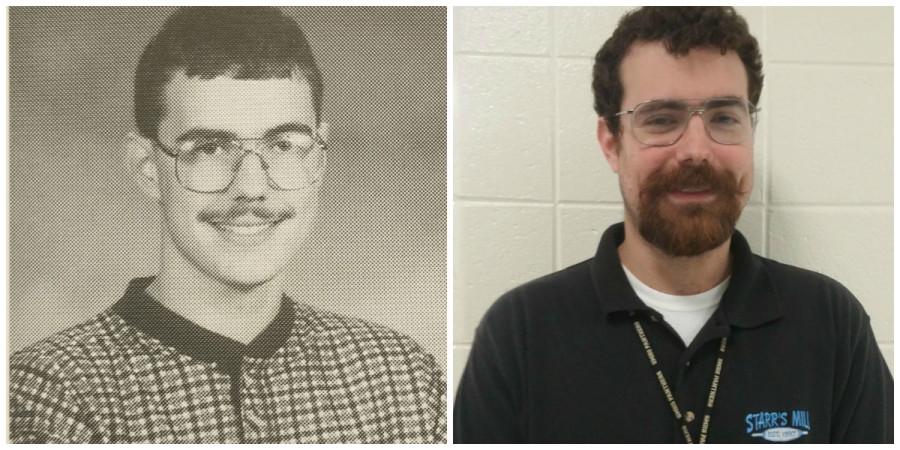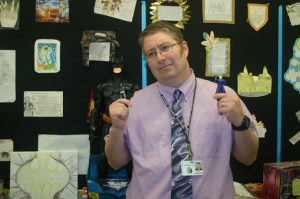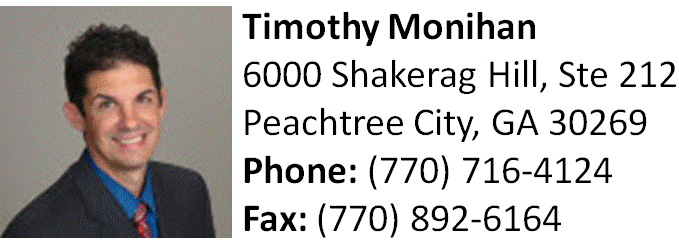SMHS alumni return to Panther family
November 2, 2015
For some students, graduation is the last time they will set foot on their high school campus. This couldn’t be further from the case when it comes to a particular handful of Starr’s Mill alumni. For these grads, Starr’s Mill is more than their old high school. It’s also their workplace.
“I am extremely grateful to be back at Starr’s Mill,” psychology teacher and charter class graduate Sean Hickey said. “I think it is my way of hopefully trying to continue to bestow the values and principles that were inscribed in me by Fayette County schools.”
Parapros Austin Enriquez and Claire Goodrich, science teacher Nicole Trahan and math teachers Emily Woodward and Derek Abrams came back to the Mill right out of college. Their high school teachers quickly became their colleagues, which turned out to be quite an adjustment. “Pretty much everyone who taught me is still here,” said Enriquez, who graduated in 2007.
Calculus teacher J.B. Campbell taught both Abrams, class of 2008, and Woodward, class of 2006, and he said the transition was difficult to get used to. “I know them only as students, so when they become coworkers, that’s a strange dynamic,” he said. “They’re not the same people they were four or five years ago at all, yet they’re still my students.”
Though this could potentially create uncomfortable situations, Trahan, class of 2008, insists the social shift isn’t too strange. “Working with them isn’t awkward,” Trahan said, “except when they make adult jokes. It’s like, no! You were my teacher!”
Campbell believes the transition was probably harder on him than on the grads. Woodward and Abrams both agree, and said they adjusted pretty quickly. “It actually made the transition easier,” Woodward said, “because I already had a relationship with [the teachers]. It wasn’t that weird. I think it made it better.”
Goodrich, class of 2011, agreed that it was “kind of cool” to come back to teachers she knew, and it made “an easy transition into the environment.”
This quick transition from student to teacher hasn’t been the only aspect of the job that has taken some getting used to. In the years that these alums have been busy earning degrees, Starr’s Mill has had plenty of time to change in other ways. “The technology has changed a lot,” Trahan said. “When I went here we still used overheads and flip phones. In that way, student life has totally transformed.”
Abrams said that some rules have changed, like students being able to have their phones and carry backpacks, but it’s because of the “generation, not the school.”
Woodward and Goodrich noticed no real shifts in the school. “There’s really nothing different about it,” she said. “Same kind of kids, the demographics haven’t changed at all.”
Other alums thought behavioral changes were the most apparent. “No one gets in trouble anymore,” Enriquez said. “Fighting wasn’t tolerated when I was here.”
For Hickey, who graduated with Starr’s Mill’s charter class in 2000, changes to the school are even more obvious. “School population has been a major change,” Hickey said. “Starr’s Mill was very small when I graduated.”
Hickey has also witnessed the evolution of some classic Panther traditions. “The senior walk was slower and it was a bit more focused on saying goodbye to the teachers,” Hickey said. “It was more of a chance to say goodbye to everyone like friends, favorite teachers, and administration, but no parents were there. It’s just become something different, which is interesting.”
Some changes have also occurred to homecoming week since the early days of Starr’s Mill. “We had character days,” Hickey said, “but I don’t remember it being a yearly highlight. Pep rallies were also more exciting.”
That’s not to say that pep rallies have entirely lost their charm, according to Hickey. “The most recent pep rallies reminded me how we used to do them years ago,” he said. “There was a lot of student involvement. That was neat, seeing that.”
Woodward said her graduating class began ringing the bell at graduation, but other than that, no new traditions have been adopted. “It hasn’t changed at all, really,” she said. “Same spirit days, homecoming week is the same.” The atmosphere at the football games has also stayed constant, with the student section being in the same spot, the tailgaters painting up and the rivalries being just as fierce.
“It’s good to know all the old rivalries still exist,” Enriquez said. “Although now that I’m a coach and not a member of the team, I can’t get away with booing the McIntosh athletes,” he joked.
Enriquez, who ran cross-country when he was a student, is now a track and cross-country assistant coach. And Enriquez isn’t the only alum who has continued some of their high school interests during their return.
For Trahan, this continued passion is cheerleading. “I was a varsity competition cheerleader for all four years,” she said. Currently, Trahan coaches varsity cheerleading with Mandy Ratliff as well as basketball cheerleading.
Woodward went to Piedmont College to play basketball, and when she secured her position as a teacher, she said it was “just understood that I would be the [basketball] coach.”
Hickey said that he participated in debate during high school, but only the public forum form of competition was offered. “When I came back to teach and then coach, I was amazed at the number of opportunities the debate and speech students had to participate,” he said. He took the speech coach position after coaching swim and lacrosse. “I enjoyed those experiences, but I didn’t have a lot of practical experience and I had to learn a lot while doing it,” he said.
When Abrams was hired, he became the new swim coach, and now he also coaches baseball because of his experience with it in high school. He played all four years and “wanted to coach it” when he came back.
All these alumni had unique high school experiences, and different stories of how they came back to teach.
Hickey, Woodward, Goodrich and Abrams planned to stay in the area. “I wanted to stay local,” Woodward said. “I interviewed at Fayette County and here because my entire family lives here.”
Goodrich’s husband now works at Fayette County, so she knew they would be back around this area, and when a spot opened up, Goodrich jumped at it. “It was an out-of-the-blue opportunity, and I was really excited about it.”
Hickey and Abrams looked for teaching positions around areas of Georgia they knew, and Abrams actually got hired at a Tift County school. During the time it took them to process his contract, coach Brent Moseley informed him of a math opening at SMHS.
He interviewed during finals week and got the job, declining his other option. Before becoming a teacher, he spent that spring semester substitute teaching and adjusted to working with his old teachers. “It’s definitely helpful in the fact that I could come in with my first year of teaching and feel comfortable with the people around me,” Abrams said.
For Trahan, this involved a change of plans during college. “In high school, I was planning to be a nurse,” she said. “Eventually I realized I wasn’t going to enjoy it, so I changed paths.” Trahan received a degree in chemistry, which equipped her to become a science teacher. “Even though my degree is in chemistry, I love all sciences,” Trahan said.
Trahan currently teaches biology and as well as a class new to the Mill, forensics. “I minored in forensics, so I was happy to teach the class,” she said.
Enriquez originally planned on joining the Coast Guard and working in enforcing fishing and other maritime laws. “I thought I was going to teach when I retired,” Enriquez said, “but that obviously changed.”
Enriquez had to rethink his plans when he found out that his shellfish allergy made him ineligible for his desired position with the Coast Guard. “It was disappointing, being told ‘no.’” But I’m able to laugh about it now,” he said.
After some time passed, Enriquez moved back to the Peachtree City area and started to coach track in the community. “Ms. Toney heard about what I was doing and she lassoed me in near the end of last semester,” he said. This year, Enriquez is working as a parapro.
When it comes to the future, Enriquez plans to stick around for a while. “I want to get certified and become a science teacher,” he said. “If I’m not working at Starr’s Mill, I will probably be working somewhere else in the county.”
Hickey, Abrams and Woodward all have plans to stay at the Mill, satisfied with their classroom but still open to future changes. “My first love truly is the classroom and the interaction and engagement and analytical discussions with the students,” Hickey said. Who knows what the future may hold, but for now, I very much enjoy my classroom.”
Goodrich, on the other hand, is “playing it by ear” because her initial focus on elementary education. “I think eventually I’ll pursue elementary school, but right now, I really like being at Starr’s Mill,” she said.
Though their plans may differ in the details, most of these alums plan on staying at the Mill for the rest of their career. Hickey considers this proof of Starr’s Mill’s excellence. “I really think that it shows a school’s merit that people come back to teach,” he said.







